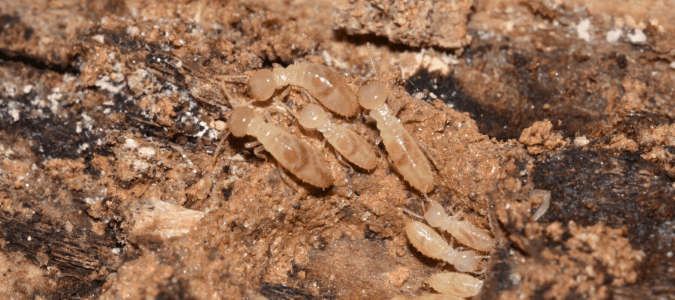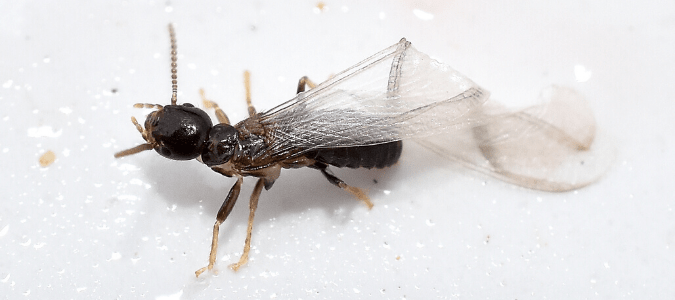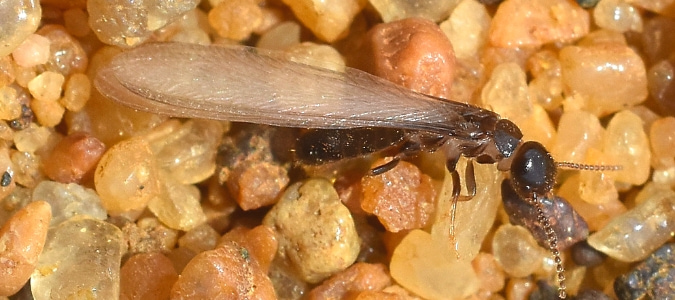Subterranean termites may be responsible for the most damage to U.S. homes each year, but Formosan termites come in at a close second. In fact, Formosan termites are sometimes called “super termites” because they destroy wood faster than their subterranean cousins. If you spot Formosan termite swarmers in or near your home, it’s a sign of an infestation. That means it’s time to take action before they destroy your property any further.
One thing to understand about Formosan termites is that they are actually a type of subterranean termite. Subterranean means underground, and that’s where these termites build their colonies. Just like the termites we more commonly call subterranean, Formosans also build mud tubes along foundations, walls or support beams. They use these tubes to connect their colonies to their food source—wood.
The problem that all types of termites pose in our homes is that they chew through wood for its cellulose. Cellulose is the plant fiber within the wood, which gives wood its structure. When termites chew through it, they create tunnels and chambers. This weakens the wood’s structure, leaving it vulnerable to breaking down over time.
The main difference between subterranean and Formosan termites is that Formosans don’t only nest in the ground. They also build nests inside wall voids. Formosan termites build these nests with a mixture of mud, chewed bits of wood and their own feces. Their secondary nests hold in the moisture these pests need to survive.
In fact, one tool that pest control professionals use to find Formosan termite colonies is a moisture meter. These meters can detect the higher moisture level within a wall that holds a termite nest.
Since these secondary wall nests hold the moisture the termites need, they don’t have to return to their underground colonies as often. That means they can stay in the wall longer.
This points to the main thing everyone should know about Formosan termites: They are incredibly destructive to wood structures. Their colonies can number in the hundreds of thousands, or even up to two to three million.
With such huge colonies, you can see how termites can do so much damage to homes, fences, garages, boats, decking and more. They can also do lots of damage to trees, including live ones. This is why it’s so important to treat these pests as soon as possible by calling a pest control professional that can stop them from destroying your home and property.
Identifying Formosan Termites
In the U.S., you can find Formosan termites in Texas and other southern states. They are found as far north as North Carolina down to Florida and west to California. They can even be found in Hawaii. Formosan termites originated in southern China and were introduced to the continental U.S. by way of Taiwan in the mid-1950s. (The word “Formosan” refers to Taiwan’s indigenous peoples who live in the interior of the island.)
Like the colonies of other subterranean termites, Formosan termite colonies can be enormous, with several million termites living in a single colony. With those numbers, it’s easy to see how they can do so much damage! They are also considered to be aggressive, which adds to their ability to destroy property. These pests are incredible diggers. They can build colonies that extend hundreds of feet below the surface of the ground.
Formosans look a bit different from their subterranean cousins. Their swarmers are a tan color, rather than gray to black, like subterranean termite swarmers. Formosans’ bodies and heads are also a bit smaller than those of subterranean termites. Their head shape is also different—less rectangular, and a bit more like a teardrop.
There are lots of similarities between Formosan termites and other termite species, of course. Like other termites, Formosan colonies consist of eggs, larvae and nymphs—the youngest termites. The larvae and nymphs grow into adult termites, which become either workers, soldiers or reproductives in the colony. Adult termites can live a couple of years. The queen of the colony might live as long as 10 years if conditions are right and the colony is not eliminated by a pest control specialist.
A colony’s reproductives are the winged swarmers that fly out of the nest to mate and build new colonies. They look a lot like flying ants, but there are some noticeable differences. Termites have two pairs of wings that are the same length as each other. Ants have one longer pair of wings and one shorter pair. They also have a much smaller “waist” than termites.
Formosan termite swarmers have tan bodies that are about a quarter of an inch long. Their primary role within the colony is to fly out during the swarming season—late spring or early summer—and find a mate. Once they mate, they shed their wings and build a new nest to lay eggs and found a new colony.
Formosan Termite Soldiers
The soldiers in a Formosan colony have brown heads and light-tan bodies. Like the swarmers, they are about a quarter of an inch long. They have large, strong mandibles—their pincer mouthparts that they use to defend their colonies. A termite colony’s main enemy is ants. Defending the nest against these enemies is a termite soldier’s primary job.
The workers of a Formosan termite colony are cream-colored and small, only about an eighth of an inch long. These termites are the ones that are responsible for bringing food to the colony. They typically stay within their nests, their mud tubes, or the wood they feed on.
It’s rare to see either Formosan termite workers or soldiers since both types of termite almost never come out into the light. If you see any Formosan termites around your home, you’re most likely to see the winged swarmers during swarming season. Seeing Formosan termite swarmers is a strong sign that you have an infestation.
There are other signs of a Formosan termite infestation, too. You might see the wings they shed after mating. Or, you might spot the mud tubes they build to connect their nest with their food source. These tubes can be found running upward from the ground along a building’s foundation, or along support beams.
If you think you may have Formosan termite swarmers on your property, it’s time to contact a pest control professional to identify and then control the termites. The longer these pests go untreated, the more damage they will do to your home and property. The destruction they cause is dangerous and can be very expensive to fix.
Formosan Termites Versus Drywood Termites
There are many differences between Formosan termites and drywood termites. The main difference is where they build their nests. Formosan termites build their colonies underground. They do this because they need the moisture found in the underground soil to survive.
Drywood termites do not need as much moisture as their subterranean counterparts do. For this reason, they don’t need to build a nest in the ground. They are able to live right inside the wood they feed on to survive. This is why they are most often found in the humid and coastal areas along the southern United States.
Drywood termite colonies are typically a lot smaller than Formosan colonies. A Formosan termite colony can have millions of members. Drywood colonies, on the other hand, usually contain only a few thousand members.
Formosan termites can eat a wide variety of types of wood. They can chew through the wood framing of a home or deck or even the live wood of an otherwise healthy tree. Additionally, they have actually been known to chew through things that aren’t made out of wood in order to get to the wood they need to feed on. They can get through drywall and plastic, and even very thin metal, with their strong mandibles.
True to their name, drywood termites are more attracted to drier wood than damp wood. They are more likely to eat their way through hardwood flooring or wooden furniture than other types of termites.
Both Formosan and drywood termites typically stay hidden. This means they might be inside our homes, damaging the structural integrity by chewing through the wood and weakening it over time. This is actually how termites cause so much damage. They go undetected for long periods of time unless you know the signs to look out for. This is why it’s important to contact a pest control professional at the first sign of termites. They have the tools and training necessary to treat these pests.
When Termites Swarm
One sign of a termite infestation is termites that are swarming, or flying out from their nest to mate. Termite swarmers are the only type of adult termites with wings. When it’s swarming season—usually late May or early June, and often after a rain—the winged swarmers venture out of the colony in large numbers. They are drawn to light, so you might see them swarming around a light fixture or at the edge of a door or window.
When termite swarmers mate, they drop their wings before disappearing again when they go to form new colonies. Piles of shed wings are another sign of a termite infestation. You might see these wings on window sills or near exterior doorways.
Drywood termites don’t build mud tubes, but Formosan termites do. Pencil-thin tubes of mud, often found on the outside of a building or underneath raised decking, are another sign of Formosan termite activity. Damaged wood that has tunnels and small chambers inside it can be a sign of either Formosan or drywood termites.
If you think you have any type of termite, contact a pest control specialist to determine which type you have on your property. They will treat the pests in all stages of their life cycle and protect your most important investment, your home.
ABC Can Help Texans Avoid Termite Damage
Given the potential damage that termites can cause, it’s not a good idea to rely on home remedies for termites. The experienced technicians at ABC Home & Commercial Services know exactly where these pests like to hide. We can create a customized treatment plan for your home that incorporates scientifically proven treatments that can eliminate the entire colony of termites. In addition, we offer an ongoing termite monitoring program that can put your mind at ease and help you avoid any potential problems.



